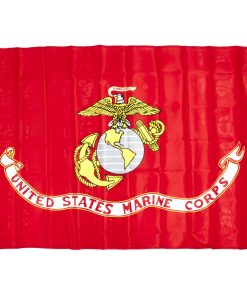Flag of the United States Marine Corps 3′ x 5′ New Made Items
$ 14,95 $ 8,97
New Made Item: Quality 3′ x 5′ flag. Ready to display. Complete with 2 hang side Grommets. Recommended for indoor use only; Synthetic.
The flag of the United States Marine Corps (also known as the standard or battle color) is the flag used to represent the U.S. Marine Corps, as well as its subsidiary units and formations.
The official flag is scarlet with the Corps emblem in gray and gold. It was adopted on 18 January 1939, although Marine Corps Order 4 had established scarlet and gold as the official colors of the Corps as early as 1925. The indoor/parade version is bordered by a gold fringe while the outdoor version is plain.
Very little information is available regarding the flags carried by early American Marines, although indications are that the Grand Union Flag was carried ashore by the battalion led by Captain Samuel Nicholas on New Providence Island, 3 March 1776. It is quite possible that the Gadsden flag was also carried on this expedition.
The standard carried by the Marines during the 1830s and 1840s consisted of a white field with gold fringe, and bore an elaborate design of an anchor and eagle in the center. Prior to the Mexican-American War, this flag bore the legend “To the Shores of Tripoli” across the top. Shortly after the war, the legend was revised to read: “From Tripoli to the Halls of the Montezumas.”
During the Mexican and Civil Wars, Marines in the field apparently carried a flag similar to the national flag, consisting of red and white stripes and a union. The union, however, contained an eagle perched on a shield of the United States and a half-wreath beneath the shield, with 29 stars encircling the entire design. Beginning in 1876, Marines carried the national colors (the Stars and Stripes) with “U.S. Marine Corps” embroidered in yellow on the middle red stripe.
At the time of the Vera Cruz landing in 1914, a more distinctive standard was carried by Marines. The design consisted of a blue field with a laurel wreath encircling the Marine Corps emblem in the center. A scarlet ribbon above the emblem carried the words “U.S. Marine Corps,” while another scarlet ribbon below the emblem carried the motto “Semper Fidelis.”
Orders were issued on 2 April 1921 which directed all national colors be manufactured without the yellow fringe and without the words “U.S. Marine Corps” embroidered on the red stripe. This was followed by an order dated 14 March 1922, retiring from use all national colors still in use with yellow fringe or wording on the flag. Following World War I, the Army practice of attaching silver bands carrying inscriptions enumerating specific decorations and battles was adopted. This practice was discontinued on 23 January 1961.
Marine Corps Order No. 4 of 18 April 1925 designated gold and scarlet as the official colors of the U.S. Marine Corps. These colors, however, were not reflected in the official Marine Corps standard until 18 January 1939, when a new design incorporating the new colors was approved. The design was essentially that of today’s Marine Corps standard.
For a brief time following World War I, the inscribing of battle honors directly on the colors of a unit was in practice, but realization that a multiplicity of honors and the limited space on the colors made the system impractical, and the procedure was discontinued. On 29 July 1936, a Marine Corps Board recommended that the Army system of attaching streamers to the staff of the organizational colors be adopted. Such a system was finally authorized by Marine Corps Order No. 157, dated 3 November 1939, and is currently in practice. Devices are embroidered onto the streamer to denote special recognition or repeat awards. Unlike the Army and Air Force flags, only a single streamer is utilized for a single campaign, with the exception of those streamers that require more than eight devices, the maximum any one streamer may hold. Devices are only authorized for campaigns participated in the 20th and 21st centuries.
Prompt Shipping and Professional Packaging
We provide a variety of shipping options due to our long-running partnerships with UPS, FedEx and DHL. Our warehouse personnel are well trained and will pack the goods according to our exact and precise specifications. Before shipping your items will be thoroughly inspected and secured. Every day, we deliver to thousands of customers in different countries. This is a sign of our determination to become the largest online retailer worldwide. Both Europe as well as the USA have warehouses and distribution centers.
Note that orders containing more than one item will be subject to a processing period that is based to the particular item.
Prior to shipping the items, our staff will carry out an exhaustive inspection of the products you ordered. Today, most orders will be delivered within 48 hours. The estimated delivery time is between 3-7 days.
Returns
The stock is constantly changing. It's not entirely managed by us since we are involved with multiple entities, including the factory and our storage. Therefore, the actual inventory could alter at any time. It is possible that you will not receive your order after the order has been made.
The period of time is 30 days. Unfortunately, if 30 days have passed since you purchased your product, we are unable to provide a refund or exchange.
The item must not be in use and must be in the original packaging. The item must be in the original packaging.
Related products
Uncategorized
Uncategorized
Uncategorized
Uncategorized
Uncategorized
Uncategorized
Angolan Rebel 1970s era 60mm Inert Display Mortar from Angolan Civil War Original Items
Uncategorized
Uncategorized
Armored Burgonet Helmet & Polearm from Scottish Castle Leith Hall Circa 1700 Original Items
Uncategorized
Uncategorized
Uncategorized
Uncategorized
Armoured Fighting Vehicles of the World: AFVs of World War One (Hardcover Book) New Made Items
Uncategorized
Uncategorized
Uncategorized
Uncategorized
Uncategorized
Uncategorized
Uncategorized






































































